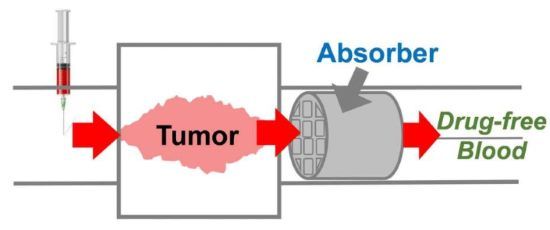Researchers have found a way to alleviate the side effects of chemotherapy
Special sponges placed in veins to absorb excess cancer drugs may prevent the side effects of these toxic chemotherapy agents, according to researchers in California.
Many patientsóin cancer sufferers undergoing chemotherapy, whichórej is accompanied by a whole range of very unpleasant effectsóin side effects such as vomiting, diarrhea, hair lossów and weakened immune systems. The agents used for chemotherapy are toxic. Kill comócancerous tumor cells, but also destroy healthy ones.
One of the waysóIn the solution to this problem is the direct delivery of the drugów into the tumor using a catheterów. But even with such precise treatment still more than 50 percent toxic compoundsóin enters the bloodstream. This can be prevented by a special sponge implanted into a vein near the tumor, whichóra absorbs toxic agents, but allows the blood to flow freely.
A sponge is an absorbent polymer shell with a cylinder manufactured using 3D printing techniques. This makes it possible to precisely adjust the size of theów implants into a particular patient’s vein, by któThe mouthpiece has been developed by Dr. J. K. K., who is responsible for the development of the device – such as. liver in the case of canceróin the liver. The device is intended to absorb excess agentsów used in chemotherapy by preventing them from spreading through the rest of the body.
The results of a study by researchersów from the University of California at Berkeley, the University of California at San Francisco and the University of North Carolina were published in the journal „ACS Central Science”.
Work on the implant is still at a very early stage, and so far the sponge has only been tested on pigs, but tests have yielded very promising results. In their experiments, the researchers focused on liver cancer. – We are developing a device focusing on liver cancer because it is a major public health threat. Every year we have tens of thousands of new cases ofów. We already treat liver cancer with intravenous chemotherapy, said Steven Hetts of the University of California, San Francisco.
– But you can use this type of approach for any tumor or any other disease, która is limited to a specific organ. In this wayób you can remove the drug before it spreads and causes side effects elsewhere. Ultimately, we would like to use this technology also in other organs to treat, for example, canceróin the kidney and tumoróin mózgu – noted.
– Surgeons, after inserting a guidewire into the bloodstream, place a sponge quite like a stent is implanted. The device is left inside for the duration of chemotherapy – perhaps for a few hours, said Nitash Balsara of the University of California at Berkeley.

Hetts treats cancer by delivering chemotherapy directly to the tumor. With this approach, a higher dose of the drug can be used. Nevertheless, typically more than half of the dose injected into the body escapes the target organ. A few years ago, he started thinking about filtering the blood coming out of a diseased organ to remove excess chemo, so that much less of the drug reaches the body as a whole.
Balsara, on the other hand, is an engineer and chemist who specializes in ionic polymers for batteriesów and fuel cells. It was to him that Hetta turned in his search for a suitable absorber, whichóry could be introduced into the body. In 2016, such a polymer was found, który effectively absorbs doxorubicin used in chemotherapy.
– Absorber is a standard chemical engineering concept, Balsara said. – Absorbers are used in oil refining to remove unwanted chemicals such as sulfur. Literally, we’ve taken the concept out of oil refining and applied it to chemotherapy. However, throughout our concept, it is very important to match the cylinder to the vein of the. If it’s not perfect, blood with the dissolved drug will flow through the cylinder without interacting with the absorbent – added.
In the experiments presented in „ACS Central Science” Hetts implanted a 3D-printed device into a pig vein and measured how much of the injected doxorubicin the implant absorbed. It turned out that the sponge removed 64 percent of the. of the drug in a healthy pig.
Hetts acknowledged that further animal testing is not the next step. Scientist wants conditional FDA approval of his therapy for human trials. The FDA (Food and Drug Administrationó(w) deals with the control of drugsóIn the U.S. – Because it is a temporary device, there is a lower bar in terms of requirements for the sponge to be approved by the FDA. I think that this type of chemofilter is one of the mostótighter pathways for patientów and it is much more realistic to test it in humans, któers with cancer, rather than continuing the testóin animal – added.
Developed by American scientistsów sponges can be used in many types of canceróin and many types of drugóin chemotherapy. They could also potentially be used to apply other dangerous drugsów, such as high-potency antibiotics, które are toxic to the kidneys but required to kill the pathogen.
